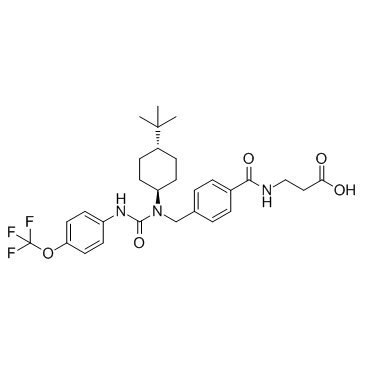| Description |
GRA Ex-25 is an inhibitor of glucagon receptor, with IC50 of 56 and 55 nM for rat and human glucagon receptors, respectively.
|
| Related Catalog |
|
| Target |
IC50: 56 nM (rat glucagon receptor), 55 nM (human glucagon receptor)[2]
|
| In Vitro |
GRA Ex-25 binds a human glucagon receptor (h-GlucRbind) with Ki of 63 nM and a moderate glucagon induced adenylate cyclase inhibition (h-GlucRcyclase) with Ki of 254 nM under our assay conditions[1]. GRA Ex-25 has similar affinity to the rat and human glucagon receptors (IC50=56 and 55 nM, respectively)[2].
|
| In Vivo |
GRA Ex-25 (3 mg/kg, i.v.) significantly reduces blood glucose caused by exogenous administration of glucagon in rat model. GRA Ex-25 is able to inhibit the rise in blood glucose levels elicited by exogenous administered glucagon, most likely because of the direct inhibition of glucagon stimulated hepatic glucose output[2].
|
| Animal Admin |
Non-fasted male Sprague Dawley rats (200 g) are maintained in the anaesthetized state during the test by s.c. administration of a 1:1 mixture of Hypnorm (fentanyl, 0.05 mg/mL and fluanizone, 2.5 mg/mL) and Dormicum (Midazolam, 1.25 mg/mL). Acatheter is inserted in a jugular vein for administration of compounds. Approximately 60 min after initiation of anesthesia, test compounds (0, 1, 3, 10 and 30 mg/kg) and glucagon (3 μg/kg) are administered in 5 min intervals, respectively. Samples for determination of blood glucose concentrations are taken from the tail tip 25 and 5 min prior to administration of the compound to represent average basal values and again 10 min after administration of glucagon (time for peak response of glucagon). The results are expressed as delta values calculated as the value obtained 10 min after alucagon administration minus the average of the two basal values.
|
| References |
[1]. Kurukulasuriya R, et al. Biaryl amide glucagon receptor antagonists. Bioorg Med Chem Lett. 2004 May 3;14(9):2047-50. [2]. Lau J, et al. New beta-alanine derivatives are orally available glucagon receptor antagonists. J Med Chem. 2007 Jan 11;50(1):113-28.
|
